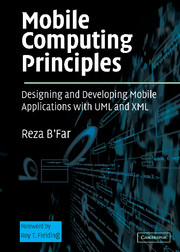Book contents
- Frontmatter
- Contents
- Foreword by Roy T. Fielding
- Acknowledgments
- SECTION 1 INTRODUCTIONS TO THE MAIN TOPICS
- SECTION 2 DEVICE-INDEPENDENT AND MULTICHANNEL USER INTERFACE DEVELOPMENT USING UML
- SECTION 3 ADDITIONAL DIMENSIONS OF MOBILE APPLICATION DEVELOPMENT
- Chapter 9 Mobile Agents and Peer-to-Peer Architectures for Mobile Applications
- Chapter 10 Wireless Connectivity and Mobile Applications
- Chapter 11 Synchronization and Replication of Mobile Data
- Chapter 12 Mobility and Location-Based Services
- Chapter 13 Active Transactions
- Chapter 14 Mobile Security
- SECTION 4 PUTTING THE PROJECT TOGETHER
- References
- Index
Chapter 14 - Mobile Security
from SECTION 3 - ADDITIONAL DIMENSIONS OF MOBILE APPLICATION DEVELOPMENT
Published online by Cambridge University Press: 03 September 2009
- Frontmatter
- Contents
- Foreword by Roy T. Fielding
- Acknowledgments
- SECTION 1 INTRODUCTIONS TO THE MAIN TOPICS
- SECTION 2 DEVICE-INDEPENDENT AND MULTICHANNEL USER INTERFACE DEVELOPMENT USING UML
- SECTION 3 ADDITIONAL DIMENSIONS OF MOBILE APPLICATION DEVELOPMENT
- Chapter 9 Mobile Agents and Peer-to-Peer Architectures for Mobile Applications
- Chapter 10 Wireless Connectivity and Mobile Applications
- Chapter 11 Synchronization and Replication of Mobile Data
- Chapter 12 Mobility and Location-Based Services
- Chapter 13 Active Transactions
- Chapter 14 Mobile Security
- SECTION 4 PUTTING THE PROJECT TOGETHER
- References
- Index
Summary
Everything that man does in his symbolic world is an attempt to deny and overcome his grotesque fate.
Ernst BeckerINTRODUCTION
Security is always one of the biggest concerns when designing any application, but particularly distributed applications. Distributed applications operate over networks, involve multiple users, and have many other properties that make them more vulnerable to security breaches. Though there are stand-alone mobile applications, as we have discussed earlier in this text, most mobile applications, at their core, are distributed applications. Unfortunately, to date, there remain many unsolved problems with security concerns of mobile applications.
Our goal in this chapter will be to first introduce a taxonomy of mobile application security problems, look at few general approaches in solving these problems, and finally review those problems that remain unsolved. Security also tends to be a system-wide problem, not just an application problem, whether dealing with mobile or stationary applications. So, we are not out to show you sample code, standards, or specific techniques; such discussions are completely beyond the scope of our discussion. Our main purpose is to take a step back and look at the big picture of mobile application design and see where security concerns may be. Security is intimately bound to the design of the platform for which the mobile application is being built.
Information
- Type
- Chapter
- Information
- Mobile Computing PrinciplesDesigning and Developing Mobile Applications with UML and XML, pp. 735 - 752Publisher: Cambridge University PressPrint publication year: 2004
